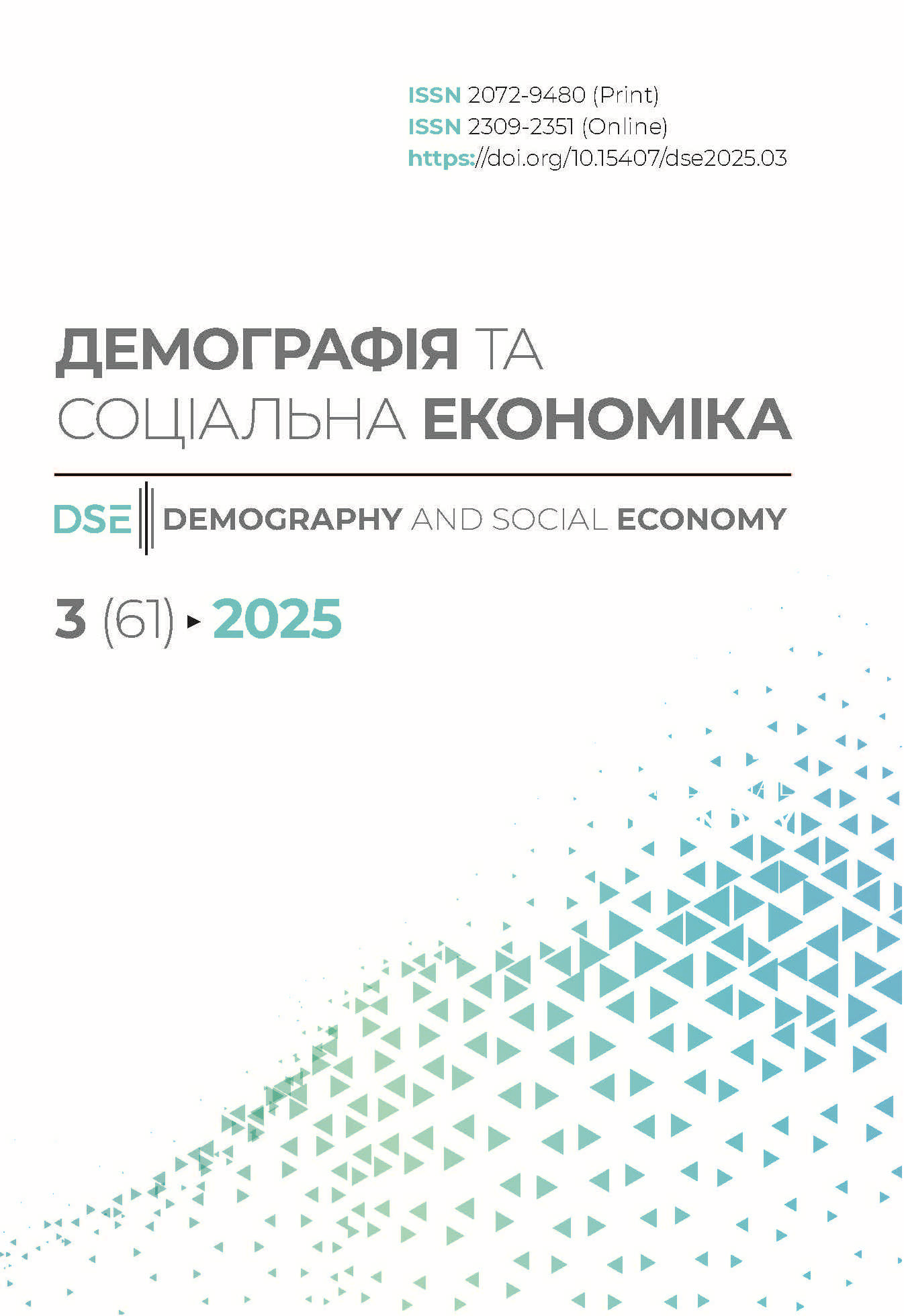HYBRID MODEL OF SOCIO-ECONOMIC REHABILITATION OF MONOFUNCTIONAL CITIES
DOI:
https://doi.org/10.15407/dse2025.03.092Keywords:
hybrid model of socio-economic rehabilitation, monofunctional cities, reconstructive spatial development, social decompression, acquired helplessness syndrome, post-war recovery, macro-regional zones of UkraineAbstract
The purpose of this study is to develop a hybrid model for the socio-economic rehabilitation of monofunctional cities as a spatially adaptive tool for Ukraine’s post-war recovery. The model integrates mechanisms of cognitive resocialization, social decompression, medical genetic monitoring, mobile employment economy, and smart regeneration to address the syndrome of learned helplessness, reduce infrastructural pressure, and enhance the role of resource-based communities in shaping quality of life. The methodological framework combines systemic, scenario-based, cognitive-behavioral, and institutional approaches with the principles of regional decompression and reconstructive development. The study employs an interdisciplinary toolkit, including scenario modeling, cluster and spatial-geographic analysis, psychometric assessment of learned helplessness, logic-project modeling, equilibrium and financial-economic evaluations, as well as the estimation of infrastructure costs and natural resource adaptation. The empirical base consists of official socio-economic indicators, legislative documents, and case studies of post-industrial city transformations in countries that have experienced prolonged crises.
The scientific novelty lies in the construction of a hybrid model of spatial rehabilitation that combines scenario-based mechanisms of social decompression, rotational labor mobility, cognitive resocialization, and financial planning tailored to the specificities of seven typologized post-war macro-regional zones in Ukraine. The study proposes a scenario programmatic approach to financing rehabilitation processes, incorporating differentiated indicators of the socio-ecological-economic conditions of territories, the extent of war-related destruction, and their recovery potential. The findings provide a methodological foundation for designing spatial rehabilitation strategies grounded in the principles of spatial development, reconstructive justice, fiscal efficiency, multilevel coordination, and cognitive empowerment in the context of post-crisis recovery.
REFERENCES / ЛІТЕРАТУРА
1. Mykytenko, V., Mykytenko, D., & Chuprina, M. (2025). Scenario modeling of spatial regeneration of macroregional zones of Ukraine: socio-ecological-economic priorities of reconstruction. Demography and Social Economy, 1 (59), 109—132. https://doi.org/ 10.15407/dse2025.01.109
[Микитенко, В. В., Микитенко, Д. О., & Чупріна, М. О. (2025). Сценарне моделювання просторового відновлення макрорегіональних зон України: соціо-екологоекономічні пріоритети реконструкції. Демографія та соціальна економіка, 1 (59), 109—132].
2. Glaeser, E. (2011). The triumph of the city: How our greatest invention makes us richer, smarter, greener, healthier, and happier. Penguin Press.
3. Florida, R. (2014). The rise of the creative class Revisited. Basic Books. https://doi.org/10.1002/9781118739044.ch15
4. Turok, I., & Bailey, N. (2004). Twin track cities? Spatial and temporal pathways of neighbourhood change. Urban Studies, 41 (11), 1—20. https://doi.org/10.1080/0042098042000243138
5. Sidenko, V. (2024). Challenges and opportunities for resilient economic development of Ukraine in the context of global transition. Economy of Ukraine, 1, 03—39. https:// doi.org/10.15407/economyukr.2024.01.003
[Сіденко, В. Р. (2024). Виклики і можливості для стійкого економічного розвитку України в контексті глобального транзиту. Економіка України, 1, 03—39].
6. Storonyanska, I., Nowakowska, A., Benovska, L., & Dub, A. (2022). Imbalances and risks of the regional development of Ukraine’s economy under conditions of instability. Agricultural and Resource Economics: International Scientific E-Journal, 8 (3), 81—97. https://doi.org/10.51599/are.2022.08.03.05
7. Zaiats, T., Romaniuk, S., Kraievska, H., Diakonenko, O., & Sova, O. (2024). Priority areas for the formation of capable territorial communities in Ukraine. Agricultural and Resource Economics: International Scientific E-Journal, 10 (1), 135—164. https://doi.org/ 10.51599/are.2024.10.01.06
[Заяць, Т., Романюк, С., Краєвська, Г., Дяконенко, О., & Сова, О. (2024). Пріоритетні напрями формування спроможних територіальних громад в Україні. Agricultural and Resource Economics, 10 (1), 135—164].
8. Seligman, M. E. P., & Maier, S. F. (1967). Failure to escape traumatic shock. Journal of Experimental Psychology, 74 (1), 1—9. https://doi.org/10.1037/h0024514
9. Seligman, M. E. P. (1975). Helplessness: On Depression, Development, and Death. San Francisco: W. H. Freeman.
10. Niederdeppe, J. et al. (2008). Public memory and public health: The role of narrative in reshaping meaning after social and environmental trauma. Health Communication, 23 (3), 315—326. https://doi.org/10.1080/10410230802229738
11. Liu, R., et al. (2017). Cumulative stress, social disadvantage, and health: Evidence from the Urban Heart Study. Journal of Urban Health, 94 (4), 584—598. https://doi.org/10.1007/ s11524-017-0171-8
12. Stresing, S., Nöfer, J. R., & Willich, S. N. (2014). Public health in post-disaster contexts: A systematic review. International Journal of Public Health, 59 (5), 713—721. https://doi. org/10.1007/s00038-014-0583-2
13. Zhang, X., Yang, H., & Li, Y. (2020). Post-industrial city transition and health risk management: Evidence from mining areas in China. Environmental Research, 188, 109778. https://doi.org/10.1016/j.envres.2020.109778
14. Tymchenko, O. I., Lynchak, O. V., & Polka, O. O. et al. (2015). Gene pool and health: na tural and artificial selection among the population of Ukraine. Kyiv: State Institution «Marzieiev Institute for Public Health of the National Academy of Medical Sciences of Ukraine».
[Тимченко, О. І., Линчак, О. В., & Полька, О. О. та ін. Генофонд і здоров’я: природний і штучний добір серед населення України. Київ: ДУ «Інститут гігієни та медичної екології ім. О. М. Марзєєва НАМН України»].
15. Pintér, L. (2019). Smart regeneration strategies in post-socialist cities. Sustainability, 11 (3), 854.
16. European Commission (2021). Smart urban regeneration: tools, technologies and participation. Horizon-2020: final report.
17. Mykytenko, V., & Chuprina, M. (2025). Polyvector scenario-forecasting model of reconstructive-spatial development of Ukraine in the post-war period. Scientific Bulletin of the International Association of Scientists. Series: economics, management, security, technologies, 4 (1). https://doi.org/10.56197/2786-5827/2025-4-1-1
[Микитенко, В. В., Чупріна, М. О. (2025). Полівекторна сценарно-прогнозна модель реконструктивно-просторового розвитку України у повоєнному періоді. Науковий вісник Міжнародної асоціації науковців. Серія: економіка, управління, безпека, технології, 4 (1)].
18. Himmelfarb, A. (Ed.). (2023). Ukraine. Rapid Damage and Needs Assessment. February 2022 — February 2023. The World Bank, the Government of Ukraine, the European Union, the United Nations. Washington, DC, 132 p. https://documents1.worldbank.org/ curated/en/099184503212328877/pdf/P1801740d1177f03c0ab180057556615497.pdf
19. Updated Ukraine Recovery and Reconstruction Needs Assessment Released (2024). World Bank Group. https://www.worldbank.org/en/news/press-release/2024/02/15/updatedukraine-recovery-and-reconstruction-needs-assessment-released
20. The World Bank in Ukraine. Ukraine remains resilient (2025). World Bank Group. https:// www.worldbank.org/en/country/ukraine/overview
Downloads
Published
How to Cite
Issue
Section
License
Copyright (c) 2025 PH «Akademperiodyka» of the NAS of Ukraine

This work is licensed under a Creative Commons Attribution-NonCommercial-NoDerivatives 4.0 International License.


